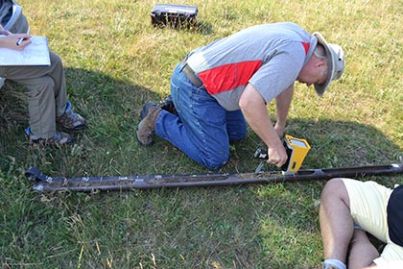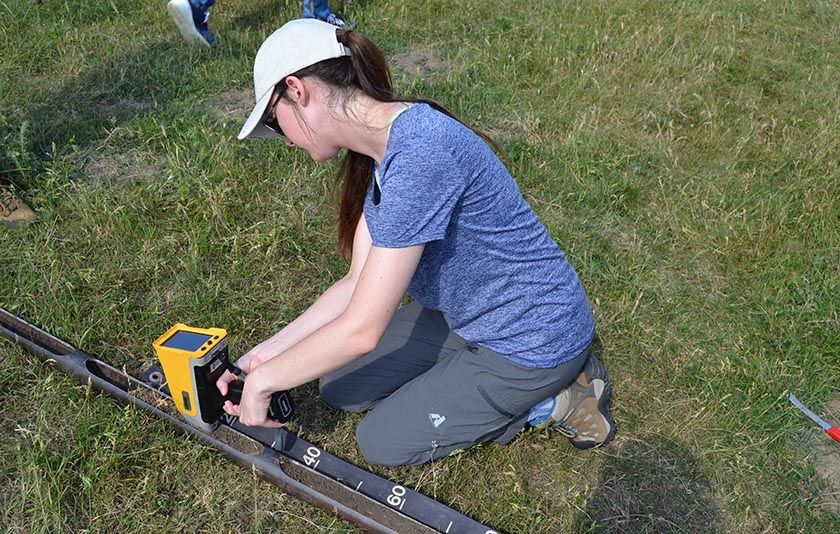Across the globe, there are many contaminated soil sites. Soil can be contaminated by both natural and synthetic metallic and organic compounds and minerals.
As populations increase, the pressure to remediate contaminated land grows. Yet, one barrier to soil remediation is the lack of cost-effective assessment options. Consequently, researchers are looking for new technologies (or combinations of technologies) to help make the remediation process faster and easier.
Professor David C. Weindorf, Department of Plant and Soil Science at Texas Tech University (TTU), and Assistant Professor Somsubhra Chakraborty, Indian Institute of Technology, Kharagpur, India discovered a cost-effective and portable soil analysis solution that combines data from two technologies: visible near-infrared diffuse reflectance (Vis-NIR) and X-ray fluorescence (XRF).
Their predictive model can relate the diffuse reflectance spectra from Vis-NIR to the elemental data provided by XRF. Here’s how it works:
Understanding the Link Between Vis-NIR and XRF for Soil Analysis
For those who are unfamiliar, Vis-NIR works by emitting visible and near-infrared light on the soil (much like a flashlight). Some of the light is reflected back to the contact probe and carried via a fiber optic cable to a backpack-mounted spectroradiometer, where the wavelengths of reflected light are precisely determined from 350 to 2,500 nm at 1 nm intervals.
Separately, the XRF analyzer collects elemental data in a complementary scan. Then, machine learning algorithms (e.g. random forest regression, boosted regression tree) are used to combine the datasets to predict the analyte of interest.
Essentially, the Vis-NIR spectrum is used as the primary modeling data while XRF elemental data is added to the model as auxiliary input data. Combining data modeling in this manner has repeatedly been shown to be more accurate than either sensor in isolation.
The detection capabilities of the two technologies are complementary. Vis-NIR is very sensitive to moisture and organic carbon compounds. XRF, on the other hand, provides robust detection for a variety of elements with environmental/agronomic implications (e.g. plant essential elements, heavy metals).
These methodologies have been applied worldwide in diverse environments, from ore mines and landfills to oil spills and wastelands.
An Award-Winning Discovery
This groundbreaking discovery has not gone unnoticed. In 2018, Drs. Weindorf and Chakraborty won a patent for determining the properties of a soil sample using Vis-NIR with XRF. And they have several other patents actively under review for related technology/advancements.
Their work has been featured in many scientific publications and led to active collaborations with the US Army Corps of Engineers and NASA. Here are two notable studies:
- Development of a Hybrid Proximal Sensing Method for Rapid Identification of Petroleum Contaminated Soils
- Synthesized Use of Vis-NIR DRS and PXRF for Soil Characterization: Total Carbon and Total Nitrogen
So, what was the XRF instrument that Dr. Weindorf turned to for his research? We’re proud to say it’s our very own Vanta™ handheld XRF analyzer.
Watch this video from TTU to hear Dr. Weindorf explain how the Vanta XRF analyzer and Vis-NIR spectrometer can work together to help researchers better understand the environment around us.
Video provided by Dr. David Weindorf
 |  |
Dr. Weindorf (left) and his doctoral student Autumn Acree (right) analyze soil with the Vanta handheld XRF analyzers in Romania.
Learn more about soil and environmental analysis using XRF by checking out our resource, Vanta for Environmental Assessments.
Related Content
Hidden Danger: Screening Garden Soil for High Levels of Lead
Brochure: Vanta for Environmental Applications
Unearthing Clues to Climate Change in the Arctic Circle with Handheld XRF
Get In Touch
.jpg?rev=B2DF)

